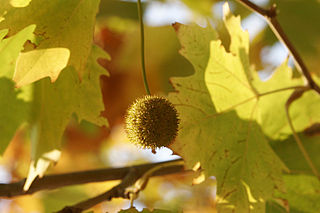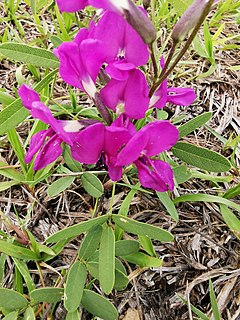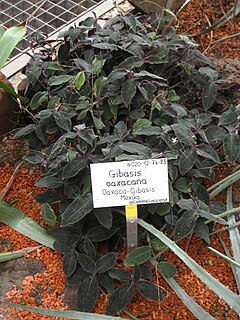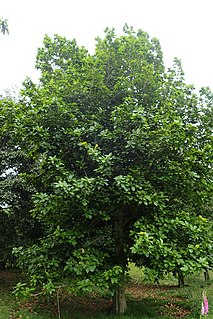
Tradescantia is a genus of 75 species of herbaceous perennial wildflowers in the family Commelinaceae, native to the New World from southern Canada to northern Argentina, including the West Indies. Members of the genus are known by the common names wandering Jew or spiderwort. Other names used for various species include spider-lily, cradle-lily, oyster-plant and flowering inch plant.

The Platanaceae are a family of flowering plants belonging to the order Proteales. This family has been recognized by almost all taxonomists, and is sometimes called the "plane-tree family". The family consists of only a single extant genus Platanus, with eight known species. The plants are tall trees, native to temperate and subtropical regions of the Northern Hemisphere. The hybrid London plane is widely planted in cities worldwide.

Solanum pseudocapsicum is a nightshade species with mildly poisonous fruit. It is commonly known as the Jerusalem cherry, Madeira winter cherry, or, ambiguously, "winter cherry". These perennials can be grown decoratively as house plants, but in some areas of South Africa, India, Australia and New Zealand it is regarded as a weed.

Columnea is a genus of ca. 200 species of epiphytic herbs and shrubs in the flowering plant family Gesneriaceae, native to tropical America and the Caribbean. The tubular or oddly shaped flowers are usually large and brightly colored – usually red, yellow, or orange – sometimes resembling a fish in shape. A common name is flying goldfish plants due to the unusual flower shape.

Maianthemum is a genus of rhizomatous, herbaceous, perennial flowering plants. It is widespread across much of North America, Europe and Asia, and may be terrestrial, aquatic or epiphytic.

Tournefortia, commonly known as soldierbush, is a genus of flowering plants in the borage family, Boraginaceae.

Chamaedorea elegans, the neanthe bella palm or parlour palm, is a species of small palm tree native to the rainforests in Southern Mexico and Guatemala. The parlor palm is one of the most heavily sold houseplant palms in the world. It is one of several species with leaves that are harvested as xate.

Psychotria poeppigiana is a plant species in the family Rubiaceae; a common name is sore-mouth bush, though it is not very often used. This species is currently accepted as Palicourea tomentosa based on a journal article published in 2011.

Solanum lanceolatum, with the common names orangeberry nightshade and lanceleaf nightshade, is a species of nightshade. It is native to regions of South America, including the Cerrado ecoregion of the Tropical and subtropical grasslands, savannas, and shrublands biome, primarily in Brazil.
Henri Guillaume Galeotti was a French-Belgian botanist and geologist of Italian parentage born in Paris. He specialized in the study of the family Cactaceae.

Martin Martens was a Belgian botanist and chemist born in Maastricht, Netherlands.

Cologania is a genus of flowering plants in the legume family, Fabaceae. It belongs to the subfamily Faboideae.

Gibasis is a genus of flowering plants within the Commelinaceae family, first described in 1837. It is native to the Western Hemisphere from Texas and the West Indies south to Argentina, with most of the species native to Mexico.

Paranomus is a genus of 18 species of flowering plants, commonly known as "sceptres", in the protea family. It is endemic to the Cape Floristic Region of South Africa.
Galium geminiflorum, the twinflowered bedstraw, is a plant species in the Rubiaceae, currently accepted as a distinct species. This 1838 name by Lowe should not be confused with the 1844 plant given the same name by Martens & Galeotti.
Vallesia is a genus of plants in the family Apocynaceae first described as a genus in 1794. It is native to South America, Central America, Mexico, Florida, Galápagos, and the West Indies.

Quercus insignis is a Mesoamerican species of oak in the white oak section, within the beech family. It is native to southern Mexico and Central America, from Veracruz to Panamá.
Smithiantha zebrina is the first Smithiantha species that was used for horticulture. It has red and yellow spotted flowers and dark green leaves. The species is native to eastern Mexico. The stems are 2 1/2 feet tall, the leaves are 5 to 7 inches long, and the flowers are 1 1/4 to 1 1/2 inches long.
Gyrandra is a genus of flowering plants in the family Gentianaceae, found in Texas, Mexico and Central America. Annual herbs, they are usually found in montane pine-oak forests.














